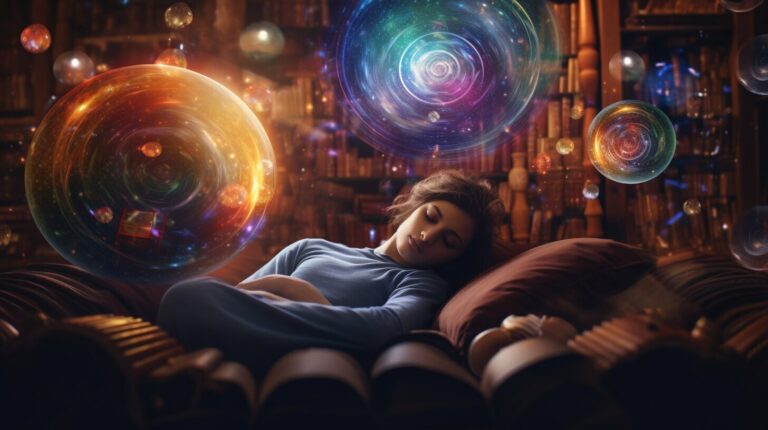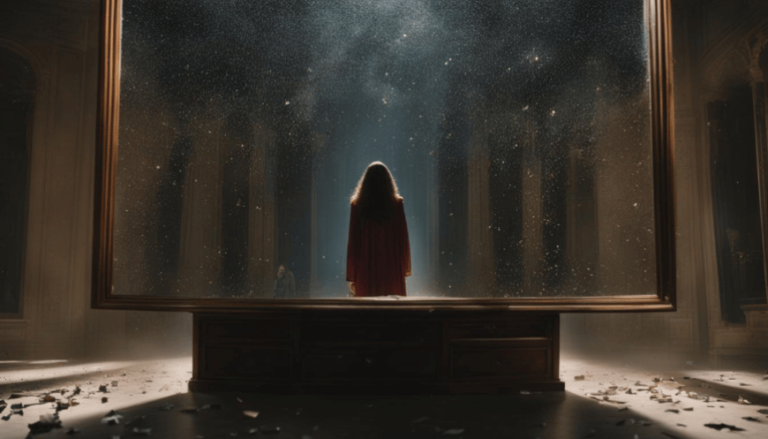*This post may contain affiliate links for which I earn commissions.*
Are you asking do
dream catchers expire and lose their effectiveness over time?
Dream catchers are often associated with catching bad dreams and providing a peaceful night’s sleep. In this article, we will explore the
lifespan of
dream catchers, how they function, and the factors that can affect their effectiveness.
Let’s delve into the world of
dream catchers and uncover the truth behind their expiration.
Key Takeaways:
- Dream catchers do not technically expire but may become less effective over time.
- Like a spider’s web, dream catchers can catch bad dreams but may become full and let a few slip through.
- The average lifespan of a dream catcher is around 2 years, but it can vary depending on factors such as the number of dreams caught, construction, and web size.
- To maintain effectiveness, dream catchers can be emptied by hanging them outside in sunlight or replaced with a new one.
- It is crucial not to break the web of a dream catcher, as it can release all the trapped bad dreams again.
The Lifespan of Dream Catchers: Do They Get Full?
Like any other object, dream catchers have a
lifespan and can gradually
become less effective. Like a
spider’s web, dream catchers are designed to
catch bad dreams and
nightmares, but over time, the web can become full and less capable of catching new bad dreams.
This can result in a few
bad dreams slipping through and reaching the sleeper.
The average lifespan of a dream catcher is around 2 years, but this can vary depending on several factors. One of the main factors is the number of
dreams caught. As the dream catcher catches more dreams, the web can become overwhelmed and less able to trap new ones.
Additionally, the construction of the dream catcher plays a role in its effectiveness. Dream catchers with high-quality materials and intricate designs tend to last longer and have better functionality than those made with cheaper materials or simpler designs.
The
size of the web also affects the lifespan, as a larger web can catch more dreams before reaching its capacity.
If a dream catcher starts to
become less effective, there are a few steps you can take to maintain its effectiveness. One option is to
hang it outside in the sunlight.
Sunlight has a cleansing and rejuvenating effect, helping to reset the energy of the dream catcher. Another option is to replace the dream catcher with a new one.
Doing so ensures that the catcher’s web is completely empty and ready to catch new dreams. However, it is important to note that breaking the web of a dream catcher should be avoided at all costs.
Breaking the web can release all the previously trapped bad dreams, negating the purpose of the dream catcher.
Table: Factors Affecting Dream Catcher Lifespan
| Factors |
Effect on Lifespan |
| Number of dreams caught |
Increased number decreased lifespan |
| Dream catcher construction |
Higher quality materials and intricate designs increase lifespan |
| Size of the web |
A larger web catches more dreams, potentially decreasing the lifespan |
In conclusion, dream catchers have a lifespan and can gradually become less effective over time. Understanding the factors that affect their lifespan, such as the number of dreams caught, construction, and web size, can help you assess their functionality.
Whether by hanging it in sunlight or replacing it with a new one, maintaining the effectiveness of a dream catcher is important to continue enjoying peaceful and undisturbed sleep.
The Functionality of Dream Catchers
Dream catchers work similarly to a
spider’s web, catching and trapping bad dreams and
nightmares.
Just as a spider’s web captures insects, dream catchers are believed to capture negative energies and prevent them from reaching the person sleeping.
The web-like design of dream catchers is thought to symbolize the interconnectedness of all things and represent the life cycle.
According to
Native American folklore, the good dreams and positive energies pass through the holes and feathers of the dream catcher, while the bad dreams and negative energies get caught in the web.
The trapped bad dreams are believed to evaporate with the morning sun, ensuring a peaceful and restful sleep for the individual.
However, as time passes, the web of a dream catcher can become full and less able to catch new bad dreams. This can result in a few
bad dreams slipping through and reaching the sleeper.
The average lifespan of a dream catcher is around 2 years, but this can vary depending on factors such as the number of dreams caught,
how the dream catcher was made, and the size of its web.
| Factors Affecting Dream Catcher Lifespan |
Description |
| Dreams Caught |
The more dreams a dream catcher catches, the more its web becomes filled, potentially reducing its effectiveness. |
| Construction |
The materials and craftsmanship of a dream catcher can influence its durability and lifespan. |
| Web Size |
A larger web may have a longer lifespan as it can catch more bad dreams before becoming full. However, it may also be more challenging to maintain. |
If a
dream catcher becomes less effective in catching bad dreams, there are ways to maintain its effectiveness.
One option is to empty the dream catcher by hanging it outside in the sunlight. The sun’s rays are believed to cleanse and purify the dream catcher, rejuvenating its ability to
catch bad dreams.
Alternatively, if the dream catcher is significantly worn or damaged, it can be
replaced with a new one to ensure continued
protection during sleep.
It is important to note that breaking the web of a dream catcher is discouraged, as this can release all the trapped bad dreams again.
To preserve its functionality and its positive energy, it is best to handle dream catchers with care and avoid tampering with their structure.
Factors Affecting Dream Catcher Lifespan
The lifespan of a dream catcher can vary depending on several factors, such as the number of dreams it has caught, its construction, and the size of its web.
Dream catchers, similar to a spider’s web, have the ability to catch bad dreams and
nightmares.
However, the web can become full over time, and its effectiveness in catching new bad dreams may decrease.
When a dream catcher becomes full, a few bad dreams may slip through the web, leading to a less effective experience. The number of dreams caught plays a significant role in the lifespan of a dream catcher.
The more dreams it catches, the faster the web fills up and loses its ability to catch new ones.
The construction of a dream catcher also affects its lifespan. Dream catchers with high-quality materials and expert craftsmanship tend to last longer than those with lower-quality materials.
The durability of the materials, such as the string, beads, and feathers, can impact how well the dream catcher withstands wear and tear over time.
Additionally, the
web’s size can influence a dream catcher’s lifespan. A larger web has a greater surface area to catch dreams, allowing it to last longer before becoming full.
Dream catchers with smaller webs may fill up quickly and require maintenance or replacement sooner.
| Factors |
Impact on Dream Catcher Lifespan |
| Number of dreams caught |
More dreams caught may decrease the lifespan |
| Construction quality |
Higher quality materials and craftsmanship increase lifespan |
| Size of the web |
A larger web tends to result in a longer lifespan |
To maintain the effectiveness of a dream catcher, there are steps you can take. If a
dream catcher becomes less effective, it can be emptied by hanging it outside in sunlight.
The sunlight is believed to cleanse the dream catcher and renew its ability to catch bad dreams.
Alternatively, when a dream catcher’s web is full or it has reached the end of its lifespan, it can be
replaced with a new one.
It is important to note that breaking the web of a dream catcher can lead to the release of all the trapped bad dreams again.
To avoid this, handle dream catchers with care and avoid damaging the delicate structure of the web.
By understanding these factors, you can better appreciate and maintain the lifespan of your dream catcher.
Maintaining Dream Catcher Effectiveness
If your
dream catcher becomes less effective over time, there are ways to rejuvenate it and maintain its effectiveness.
Dream catchers can catch bad dreams and nightmares like a spider’s web. However, over time, the web can become full, allowing a few bad dreams to slip through.
The average lifespan of a dream catcher is around 2 years, but this can vary depending on factors such as the number of dreams caught,
how the dream catcher was made, and the size of the web.
To keep your dream catcher working its best, consider these maintenance tips:
- Hang it outside in sunlight: This is an effective way to cleanse the dream catcher and recharge its energy. Sunlight can remove negative energies and revitalize the web, allowing it to catch bad dreams again.
- Replace it with a new one: If your dream catcher has reached the end of its effective lifespan, consider replacing it with a new one. This ensures you continue receiving the maximum benefits and protection from bad dreams.
Remember, it is important not to
break the web of a dream catcher. Doing so can release all the trapped bad dreams again, diminishing its effectiveness.
By taking these maintenance steps, you can keep your dream catcher working its best and enjoy peaceful nights free from bad dreams and nightmares.
| Maintenance Tips |
Description |
| Hang it outside in the sunlight |
This cleanses the dream catcher and recharges its energy, revitalizing its web. |
| Replace it with a new one |
If your dream catcher has reached the end of its lifespan, consider getting a new one for optimal effectiveness. |
Importance of Not Breaking the Web
Breaking the web of a dream catcher is not advisable, as it can undo all the capturing of bad dreams and rerelease them.
Similar to a spider’s web, the intricate design of a dream catcher’s web is essential for trapping and filtering out negative dreams and nightmares.
The web acts as a protective barrier that prevents these unsettling dreams from reaching the dreamer, ensuring a peaceful and restful sleep.
By breaking the web, you disrupt the delicate balance of the dream catcher’s functionality.
The bad dreams that were once caught and contained within the web are now set free, potentially causing them to find their way back into your dreams.
It is vital to respect the integrity of the dream catcher and avoid any actions that could compromise its effectiveness.
Instead of breaking the web, consider other methods to maintain the dream catcher’s efficacy. If you notice that the dream catcher is becoming less effective over time, you can try hanging it outside in sunlight.
The powerful energy of the sun’s rays can cleanse and rejuvenate the dream catcher, allowing it to continue fulfilling its purpose of capturing and filtering out bad dreams.
If the dream catcher has reached a point where it no longer functions effectively, it may be time to replace it with a new one.
Dream catchers are available in various sizes, designs, and materials, allowing you to choose one that resonates with you and fits your aesthetic preferences.
By replacing an old dream catcher with a new one, you ensure that the protective barrier remains intact, and you can continue to enjoy restful and peaceful nights.
Table: Factors to Consider for Dream Catcher Maintenance
| Factors |
Maintenance Methods |
| Web Integrity |
Avoid breaking the web |
| Decreased Effectiveness |
Hang it outside in sunlight or replace it with a new one |
“The web acts as a protective barrier that prevents these unsettling dreams from reaching the dreamer, ensuring a peaceful and restful sleep.”
Overall, breaking the web of a dream catcher should be avoided to maintain its effectiveness.
By respecting the importance of the web and taking necessary maintenance steps, you can continue to benefit from a dream catcher’s ability to capture bad dreams and ensure a peaceful night’s sleep.
Exploring Dream Catcher Misconceptions
Dream catchers often face misconceptions, with some believing they have the power to
ward off ghosts and
evil spirits. While dream catchers hold
cultural significance and are believed to protect against bad dreams, their abilities are not supernatural.
Despite popular misconceptions surrounding their purpose, they are not designed to ward off ghosts or evil spirits.
These misconceptions may stem from the
fascinating traditions and
legends associated with dream catchers, which often involve stories of
spirits,
ghosts, and the
devil. However, it is important to separate fact from fiction when it comes to understanding dream catchers and their true function.
Dream catchers are crafted with a spider web-like design, symbolizing the spider’s web that catches bad dreams.
As dreams pass through the web, the good dreams are allowed to flow down to the dreamer, while the bad dreams are caught and held within the web until they dissipate with the first light of day.
This mechanism is seen as a way to bring peace and tranquility to the dreamscape.
While dream catchers may not possess supernatural powers, they hold
cultural significance among
Native American tribes, particularly the
Ojibwe people.
Dream catchers are believed to offer
protection and serve as a symbol of unity. This
cultural significance has led to their enduring
popularity in
modern culture as decorative items and symbols of spirituality.
Origins of Dream Catchers
Dream catchers are rooted in
native American cultures, specifically in the
spider web design.
These intricate and beautiful creations were particularly associated with the
Ojibwe people, also known as the
Chippewa. According to their beliefs, dream catchers act as protective charms that capture bad dreams and allow only good dreams to pass through.
The
spider web design symbolizes the interconnectedness of all living things and the delicate balance between good and evil.
The
Ojibwe people believed that dream catchers were a powerful tool in warding off negative energy and protecting individuals from nightmares and bad dreams.
They would hang them above the bed or cradle, allowing the web to catch any negative energy that might disturb their sleep.
It was believed that the bad dreams would get caught in the web, while the good dreams would find their way through the center hole and gently descend upon the sleeper.
As a result, dream catchers became a significant part of their culture and traditions.
Over time, the concept of dream catchers spread to other native American tribes, each adding their own unique variations to the design and interpretation.
Today, dream catchers have become widely popular across different cultures worldwide. They are often seen as decorative elements, symbolizing unity, peace, and protection.
Many people hang them in their homes, not only as a beautiful piece of art but also as a reminder of the interconnectedness of all living things and the power of positive energy.
| Key Points: |
| Dream catchers originated from native American cultures, specifically the Ojibwe people. |
| The intricate spider web design symbolizes interconnectedness and the balance between good and evil. |
| The Ojibwe people used Dream catchers as protective charms to capture bad dreams and allow only good dreams to pass through. |
| They have now become popular symbols of unity, peace, and protection in different cultures worldwide. |
Cultural Significance of Dream Catchers
Dream catchers hold cultural significance, particularly among the Ojibwe people, who believe they provide protection.
For the Ojibwe, also known as the
Chippewa, dream catchers are deeply rooted in their spiritual beliefs and traditions.
These intricate and beautiful objects are not mere decorations but serve a powerful purpose in their culture.
The Ojibwe people believe that dream catchers act as a filter for dreams, capturing and holding onto the good dreams while allowing the bad dreams to pass through.
The dream catcher’s web, which is often weaved in a circular pattern, is said to mimic the shape of a spider’s web, symbolizing protection and the interconnectedness of all living beings.
The circular shape of the dream catchers is also significant as it represents the circle of life and the continuous cycle of dreams.
They are often adorned with feathers and beads, each carrying its own symbolic meaning.
The feathers represent breath, the vital force of life, while the beads are believed to trap any negative thoughts or energies that may be present in the dream catcher.
| Item |
Symbolic Meaning |
| Web |
Protection and interconnectedness |
| Feathers |
Life force and breath |
| Beads |
Trapping negative energies |
Dream catchers are often given as gifts to newborns or hung above beds to ensure restful sleep and protect the individual from negative dreams and
spirits.
They are also considered a powerful symbol of unity and harmony within the community, as a reminder of the interconnectedness of all people and the importance of protecting one another.
The Symbolism of Dream Catchers
“Dream catchers are not just beautiful ornaments; they hold deep spiritual meaning for the Ojibwe people. They are believed to protect individuals from negative spirits and dreams, ensuring a peaceful and restful sleep.”
The cultural significance of dream catchers extends beyond the Ojibwe people and has gained
popularity in
modern culture as well.
Their intricate designs and symbolism have captured the fascination of people from various backgrounds, making them a cherished decorative item in many households.
Although dream catchers may not have an expiration date, it is important to appreciate their cultural significance and the beliefs behind them.
When using or gifting a dream catcher, it is essential to respect its sacredness and remember that it is more than just a beautiful piece of art – a symbol of protection and unity that carries centuries of tradition and belief.
Fascinating Traditions and Legends
Dream catchers are associated with various
fascinating traditions and
legends, often involving spirits,
ghosts, and even the
devil.
These captivating stories have been passed down through generations, giving dream catchers a mystical and enchanting reputation.
In Native American cultures, it is believed that dream catchers have the power to protect individuals from negative spirits and bad dreams.
According to one legend, the Ojibwe people, also known as the
Chippewa, believe that dream catchers were first created by a spider woman.
She would weave intricate webs above sleeping infants to filter out bad dreams and allow only the good ones to pass through.
Another intriguing tradition suggests that dream catchers can capture spirits during dreams. It is believed that when a dream catcher’s web becomes full, it traps the spirits, preventing them from causing harm in the physical world.
To release these captured spirits, dream catchers are traditionally placed outside in the sunlight, where the spirits are believed to be set free.
| Traditions |
Legends |
| Protection from negative spirits |
Dream catchers created by Spiderwoman |
| Filtering out bad dreams |
Capturing spirits during dreams |
| Releasing captured spirits |
Placing dream catchers outside in sunlight |
- Traditions: Protection from negative spirits, Filtering out bad dreams, Releasing captured spirits
- Legends: Dream catchers created by a spider woman, Capturing spirits during dreams, Placing dream catchers outside in sunlight
The rich traditions and legends surrounding dream catchers add to their allure and make them highly cherished symbols in many cultures around the world.
Whether you believe in their mystical power or simply appreciate the beauty of their design, dream catchers continue to captivate both young and old alike.
Dream Catchers in Modern Culture
Dream catchers continue to have a presence in
modern culture, often being seen as
symbols of unity and peace.
These beautiful, intricate creations have transcended their Native American origins and have become popular decorative items and meaningful gifts.
They adorn walls, windows, and even rearview mirrors, spreading their mystical charm.
In today’s society, dream catchers are embraced by individuals from various backgrounds who appreciate their aesthetic appeal and the symbolism they represent.
They are often associated with positive energy, protection, and the filtering of bad dreams.
Many people are drawn to dream catchers as a way to connect with the spiritual realm, seeking solace, and tranquility through their presence.
With their delicate webs enmeshed with colorful beads and feathers, dream catchers have become an iconic symbol of unity and peace.
They are cherished by individuals and communities alike, and their
popularity has extended far beyond their Native American roots. Dream catchers are often gifted to loved ones as a token of blessings, hope, and dreams fulfilled.
They serve as a reminder to focus on the positive and to let go of negativity that may hinder personal growth and happiness.
| Symbolism |
Meaning |
| Web |
Represents the interconnectedness of all things and the journey of life. |
| Beads |
Symbolize the dreams and aspirations we hold close to our hearts. |
| Feathers |
Represent the breath of life, bringing good dreams and positive energy. |
The presence of dream catchers in modern culture is a testament to their enduring appeal and the power of their symbolism.
Whether hung above a bed, in a meditation space, or adorning a car, dream catchers continue to captivate hearts and minds, reminding us to chase our dreams and embrace the unity of all beings.
In Conclusion
Dream catchers do not have an expiration date, although their effectiveness can diminish over time. However, they remain culturally significant and are cherished symbols in modern culture.
Similar to a spider’s web, dream catchers have the ability to catch bad dreams and nightmares. However, as the web becomes full, it can become less able to catch new bad dreams, resulting in a few slipping through.
This is why their effectiveness may decrease over time.
The average lifespan of a dream catcher is around 2 years, although this can vary depending on several factors.
The number of dreams caught, the construction of the dream catcher, and the size of its web can all affect how long it effectively filters out bad dreams.
If you notice that your dream catcher has become less effective, several ways exist.
You can empty the dream catcher by hanging it outside in the sunlight, releasing the trapped dreams. Alternatively, you can replace the dream catcher with a new one to ensure continued effectiveness.
It is important to note that breaking the web of a dream catcher is not advisable, as this can release all the trapped bad dreams again.
To preserve the intended functionality of the dream catcher, it is best to keep the web intact.
Despite any limitations in their effectiveness, dream catchers hold a significant place in cultural traditions and continue to be valued symbols in modern culture.
Their enduring popularity speaks to their ability to inspire unity and ward off negative energy, making them timeless pieces of art and protection.
Can Dream Catchers Unlock Past Memories?
Dream catchers have long been associated with Native American culture and the belief of unlocking past memories. While scientific evidence is lacking, some individuals believe that these intricate webs can capture negative dreams, leaving space for positive ones and potentially unlocking past memories. Their significance as a spiritual tool is intriguing, providing a sense of comfort and connection to ancestral wisdom.
FAQ
Do Dream Catchers Expire?
Dream catchers do not technically expire but may become less effective over time.
What is the Lifespan of Dream Catchers?
Dream catchers have an average lifespan of around 2 years.
How do Dream Catchers Function?
Dream catchers work similarly to a spider’s web, catching bad dreams and nightmares. However, when the web becomes full, a few bad dreams may slip
through.
What Factors Affect the Dream Catcher Lifespan?
The lifespan of a dream catcher can be influenced by factors such as the number of dreams caught,
how the dream catcher was made, and the size of the web.
How Can I Maintain Dream Catcher Effectiveness?
If a dream catcher becomes less effective, it can be emptied by hanging it outside in sunlight or replaced with a new one.
Why is it Important Not to Break the Web?
Breaking the web of a dream catcher can release all the trapped bad dreams again, so it is important to avoid doing so.
What are Some Common Misconceptions About Dream Catchers?
Some misconceptions about dream catchers include believing they can
ward off ghosts or
evil spirits.
What are the Origins of Dream Catchers?
Dream catchers originated from Native American cultures, particularly the Ojibwe people, and feature a unique spider web design.
What is the Cultural Significance of Dream Catchers?
Dream catchers hold cultural significance for the Ojibwe people and are believed to offer protection.
Are There Fascinating Traditions and Legends Surrounding Dream Catchers?
Various traditions and legends are associated with dream catchers, often involving spirits,
ghosts, and the
devil.
How are Dream Catchers Portrayed in Modern Culture?
Dream catchers are popular
symbols of unity in modern culture and can be found in various forms of art and decoration.
Source Links







